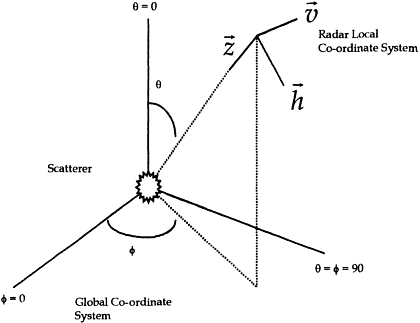266.
| [Cover] [Contents] [Index] |
Page 38
where r is the distance between the scatterer and the receiving antenna and k denotes the wave number of the illuminating wave. The scattering matrix thus describes how the ground scatterer transforms the illuminating electric field (van Zyl et al., 1987).
1.7.2 Polarisation synthesis
Knowledge of the scattering matrix [S] permits calculation of the received power Pr for any possible combination of transmit and receive antenna polarisations. This process is called ‘polarisation synthesis’ (van Zyl et al., 1987). The observed power Pr can be derived by evaluating the matrix equation (van Zyl, 1989):
 |
(1.32) |
where
 |
(1.33) |
and g(θ, Φ) is the antenna gain function, θ and Φ are the angles between the radar local co-ordinate system and the scatterer-centred global co-ordinate system shown in Figure 1.22,  is the effective area of the
is the effective area of the

Figure 1.22 The local and global coordinate systems determine the angles θ and φ.
| [Cover] [Contents] [Index] |
EAN: 2147483647
Pages: 354